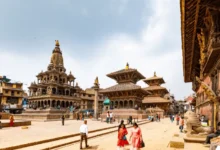Sacred Spaces: Lesser-Known Pilgrimage Routes Around the World

Pilgrimage is often a transformative journey, a physical manifestation of a spiritual or emotional quest. While pilgrimage routes like Spain’s Camino de Santiago or the Hajj in Mecca may dominate public awareness, there are countless other pilgrimage routes across the globe that offer equally rich experiences, yet remain under the radar. This blog highlights three such lesser-known pilgrimage routes and delves into the history, significance, and unique features that make each of them worthy of a sacred journey.
Mount Kailash, Tibet
In the remote western corners of Tibet lies Mount Kailash, an awe-inspiring peak that remains untouched by the foothold of mountaineers due to its immense spiritual significance. This 6,638-meter-high mountain is unique in that it is sacred to four different religions: Buddhism, Hinduism, Jainism, and the ancient Bon religion of Tibet. Because of its sanctity, climbing the mountain is considered sacrilegious, and instead, devotees circumambulate the mountain—a trek that takes about three days.
The pilgrimage is an arduous one, requiring the crossing of a high-altitude pass that reaches an elevation of nearly 5,700 meters. Yet, for those who undertake this journey, it is considered a path to enlightenment or even a way to cleanse oneself of sin. In the monasteries and hermitages along the way, pilgrims can deepen their spiritual practice and gain insights from learned monks and hermits. The austerity of the environment, the majestic vistas, and the convergence of diverse spiritual traditions make Mount Kailash one of the most unique pilgrimage destinations in the world.
Kumano Kodo, Japan
The Kumano Kodo pilgrimage routes crisscross the mountainous Kii Peninsula in Japan, offering a unique blend of natural beauty and spiritual significance. Unlike other pilgrimage routes, the Kumano Kodo is not tied to a single religion or philosophy; instead, it blends Shintoism and Buddhism, connecting several grand shrines and temple complexes. The pilgrimage can take several days or even weeks, depending on which routes are followed.
What sets Kumano Kodo apart is its inclusion as a dual World Heritage site along with the Camino de Santiago in Spain, recognizing the cultural exchange that took place between the East and the West during medieval times. Along the trail, one can find ancient teahouses and inns that have been serving pilgrims for centuries. There’s an element of “forest bathing” (Shinrin-yoku) as you walk through centuries-old forests and soak in the atmosphere, said to have therapeutic effects. The paths are dotted with Oji, small sub-shrines where pilgrims can pray and perform rituals, deepening the spiritual experience of the journey.
Lake Atitlán, Guatemala
Nestled in the highlands of Guatemala and surrounded by volcanoes and indigenous villages, Lake Atitlán is not a traditional pilgrimage site but has become a place of spiritual seeking for many. Though not associated with any major world religion, the lake holds significant spiritual value to the native Tz’utujil Maya people, who consider it to be the center of the universe.
For modern spiritual seekers, Lake Atitlán offers a variety of experiences that can be considered a form of pilgrimage. Yoga and meditation retreats abound, and many come here to study indigenous spiritual practices or engage in Mayan fire ceremonies. What’s more, the sheer natural beauty of the place—described by Aldous Huxley as the most beautiful lake in the world—offers a form of spiritual refreshment on its own. The tranquility of the lake and the surrounding landscapes make it an ideal place for contemplation and self-discovery, even if one does not adhere to any particular religious or spiritual belief.
Also Read: Maximizing Your Budget: Finding 10 Affordable Travel Adventure Solutions
St. Olav’s Way, Norway
Stretching from the ancient ruins of Oslo’s medieval cathedral to the stunning Nidaros Cathedral in Trondheim, St. Olav’s Way is a 640-kilometer (about 400 miles) pilgrimage route that meanders through the beautiful landscapes of Norway. The journey is undertaken to honor St. Olav, the patron saint of Norway, who played a pivotal role in the country’s Christianization.
The trek takes pilgrims through dense forests, alongside shimmering lakes, and across mountainous terrain. Along the route, ancient stave churches dot the landscape, offering an awe-inspiring glimpse into medieval religious architecture. Unlike other popular pilgrimage routes that may be overcrowded, St. Olav’s Way offers a more solitary experience, allowing for deep contemplation amid the tranquility of nature. Many of the stops along the way are small, charming villages where local hospitality is a hallmark. Some villages even offer pilgrim-specific accommodations, often run by volunteers who provide a warm meal, a comfortable bed, and sometimes even spiritual guidance. With its potent blend of natural beauty, historical significance, and cultural richness, St. Olav’s Way is an enriching experience for any spiritual seeker.
Adam’s Peak, Sri Lanka
Adam’s Peak, or Sri Pada as it is locally known, is a conical mountain located in central Sri Lanka. It’s a significant pilgrimage site for Buddhists, Hindus, Muslims, and Christians alike. Buddhists believe the footprint at the summit is that of Buddha; Hindus attribute it to Lord Shiva or Hanuman; Muslims and Christians believe it to be Adam’s first step after being exiled from the Garden of Eden.
The pilgrimage season typically runs from December to May, avoiding the country’s monsoon seasons. The journey to the summit is often undertaken at night to avoid the daytime heat and to reach the top in time for a magical sunrise. Along the way, pilgrims encounter numerous tea shops and rest stops offering refreshments and encouragement. The pilgrimage is not just a test of physical endurance but is also a communal experience, where the young and old, the fit and the not-so-fit, locals and foreigners all come together in a shared spiritual journey. The peak itself offers breathtaking panoramic views and a sense of accomplishment that make the arduous climb worthwhile.
Lalibela, Ethiopia
In the heart of Ethiopia, the town of Lalibela holds a mystery and allure that has captivated pilgrims and travelers for centuries. Renowned for its rock-hewn churches, which are UNESCO World Heritage Sites, Lalibela is often referred to as the “New Jerusalem” and serves as one of Ethiopia’s most important Christian pilgrimage sites. The churches, carved out of solid rock in the 12th century during the reign of King Lalibela, are an engineering marvel and a testament to human ingenuity and spiritual devotion.
Pilgrims usually visit during the Ethiopian Orthodox Christian celebrations like Genna (Christmas) and Timkat (Epiphany), where the town comes alive with religious fervor, processions, and ceremonies. These events offer a glimpse into the deep spiritual heritage and religious rituals that have been preserved for centuries. Apart from the churches, the surrounding mountains offer secluded spots for prayer and meditation, often frequented by hermit monks. A pilgrimage to Lalibela is not just a journey through awe-inspiring architecture but also a passage through time, offering a rare look into an ancient Christian tradition that has remained largely unchanged for centuries.
If the idea of a pilgrimage intrigues you, but you’re also looking for experiences that suit a more traditional holiday vibe tailored for adults, you’ll find SpinGenie.com’s blog on “Best Holiday Spots for Adult Travellers” a perfect companion read. While this blog has explored off-the-beaten-path spiritual journeys, SpinGenie focuses on destinations that offer luxury, relaxation, and adult-oriented activities. Whether you’re drawn to the introspective solitude of a trek up Mount Kailash or the buzzing nightlife of more conventional holiday spots, combining insights from both blogs could help you design a travel itinerary that satiates both your spiritual and leisurely cravings.
Each of these sacred spaces offers a unique lens through which to explore the concept of pilgrimage—be it traditional, interfaith, or even secular. While these routes may not be as well-known as others, they provide rich experiences for those willing to undertake the journey.






